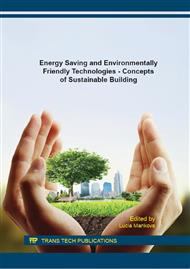[1]
Information on http: /vetrani. tzb-info. cz/8076-modelovani-fyzikalnich-jevu-1-odpar-z-vodni-hladiny.
Google Scholar
[2]
Jokl, M. Zdravé obytné a pracovní prostředí. 1st ed. Praha: Academia, 2002, 261 p., with colour appendix ISBN 80-200-0928-0.
Google Scholar
[3]
Erhorn, H.; Gertis, K., Wohnfeuchte und Waermebruecken, HLH. Heizung, Lüftung/Klima, Haustechnik 36.
Google Scholar
[1985]
No. 3, pp.130-135 : Abb., Tab., Lit. (1985).
Google Scholar
[4]
Kalousek, M. Tepelné mosty konzolovými konstrukcemi. Tepelná ochrana budov, 2009, vol. 12, no. 3. ISSN 1213-0907.
Google Scholar
[5]
Krus, M.; Sedlbauer, K. Artifical thermal bridge with dew point switch-to enable a maintainance-free energy-saving ventilation- system for the prevention of mould growth. Fraunhofer-Institute for Building Physics, Fraunhofer, 83626 Valley, Germany 2006. 4 p.
Google Scholar
[6]
Šála, J. Zateplování budov. Grada Publishing spol s. r. o, Praha 2000. 176p. ISBN 80-7169-833-4.
Google Scholar
[7]
Bečkovský, D.; Bečkovská, T.; Vlach, F.; Vajkay, F. Diffusion of water vapour, monitoring and risk analysis of wooden walls. WOOD RESEARCH, 2014, roč. 59, č. 3, s. 431-438. ISSN: 1336- 4561.
Google Scholar
[8]
Hauser, G. Auskragende balkonplatten bei wärmeschutztechnischen sanierungen. Bauphysik 13, 1991, 144-150pp.
Google Scholar
[9]
Seung, Y. S.; Kwang, W. K.; The optimal insulation detail of the thermal bridge adjacent to hot water pipes in apartment building slabs. Department of Architecture, Seoul National University, San 56-1, Shinlim-Dong, Kwanak-Gu, Seoul, 151-742, Korea. 8p. (1997).
Google Scholar
[10]
Lopušniak, M.; Vaškova, A. Výsledky merania vybraných ukazovateľov vnútorného prostredia v budove rodinného domu. Zborník prednášok z 16. medzinárodnej konferencie Tepelná ochrana budov 2011 - Aktuálne tepelnotechnické požiadavky a trendy, Thermal protection of buildings 2011. 1st ed. 2011. BB Print, s. r. o. ISBN 978-80-970595-4-5.
Google Scholar
[11]
ČSN 060210, 1994, Z1 1999 Výpočet tepelných ztrát budov při ústředním vytápění. Český normalizační institut, 26 p.
Google Scholar
[12]
ČSN 73 0540-1, 2, 3, 4: 2005, 2011 Tepelná ochrana budov včetně pozdějších změn a dodatků. Praha: Úřad pro technickou normalizaci, metrologii a státní zkušebnictví, 2011. 44 p.
Google Scholar
[13]
ČSN EN ISO 13788: 2011 [73 0544] Tepelně vlhkostní chování stavebních dílců a stavebních prvků - Vnitřní povrchová teplota pro vyloučení kritické povrchové vlhkosti a kondenzace uvnitř konstrukce - Výpočtové metody. Český normalizační institut, 2002. 40p.
Google Scholar
[14]
Svoboda, Z. Numerické hodnocení tepelných mostů a vazeb. Praha 2004. 139 p. Habilitation thesis.
Google Scholar
[15]
Bečkovská, T. Optimalizace návrhu moderních nízkoenergetických dřevostaveb. Doctoral thesis. Brno 2015. 150p.
Google Scholar


